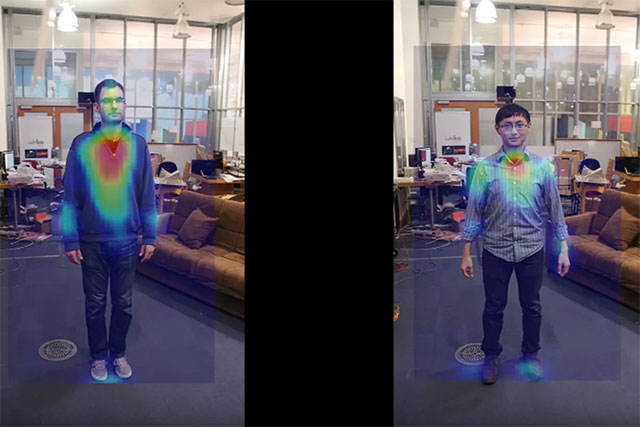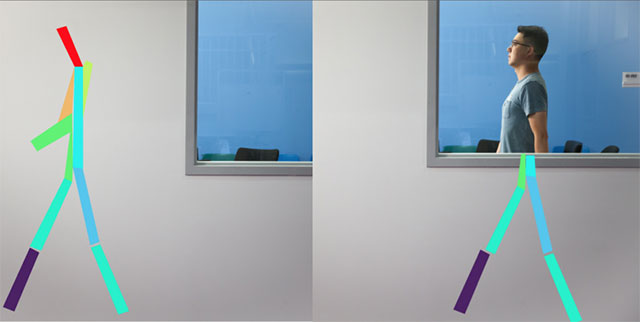AI uses WiFi data to estimate the number of people in a room
You may not know, but WiFi data can be applied to many interesting purposes. In addition to basic information such as signal strength, connection speed, or security level, WiFi data can also tell us quite a lot of information about connected objects, such as in the determination. See how many people are standing near a specific access point. In a new paper published recently with the title: 'DeepCount: Crowd Counting with WiFi via Deep Learning' - roughly translated: Estimate the number of people in a crowd via WiFi data, posted on the website Arxiv.org has succeeded in developing AI - DeepCount operational identity model - which helps estimate the number of people in a room from wireless data.

- 91% of technology managers believe that AI will be the center of the next technology revolution
The work was carried out shortly after researchers at Ryerson University in Toronto announced a neural network that could help determine whether the owner of a smartphone is walking, cycling or driving. around some areas of the city using WiFi data, and at the same time another Purdue University study has also succeeded in developing a system that uses WiFi access logs for relationship analysis. Contacts between users, their locations and activities.
In this latest study, scientists took advantage of channel state information (CSI) - specifically phase and amplitude - to create a system of two artificial intelligence models, Includes an active identification model and deep learning model. The deep learning model is tasked with assessing the correlation between the number of people and channels by mapping their activities to CSI, while the operational identity model will be responsible for recording information when Someone walks in or out of the room through an 'electronic switch'. In the case of two models that obtain incompatible data - for example, if the operational identity model records a higher number of people than the deep learning model - DeepCount will use that difference to retrain the model. deep learning.

- McAfee expert explained how deepfake and AI are drilling through the cyber security wall
In addition, the researchers have compiled a set of 800 CSI samples from 10 volunteers to participate in a variety of tasks, including activities such as waving, typing, sitting down. , walking, talking and eating (about 80% of the sample in each class is used for training purposes and the rest is used as a test kit). To train the operational identity model, scientists must first conduct amplitude data processing to eliminate noise and unwanted elements, then extract feature information. Deep-learning training is similar to the preprocessing stage, but is done with out-of-band phase data.
DeepCount running on a laptop has three receiving antennas, modified to report channel state data, and they are also connected to routers and two other transmitting antennas. Both operate on the 5GHz band to be able to produce wavelengths short enough to ensure better resolution, and also to minimize the ability to intervene from unwanted elements.

- Google and DeepMind apply AI to predict the output of wind farms
In the experiments conducted, the research team reported that this deep learning model achieved an accuracy of up to 86.4% with up to 5 people. In addition, with the retraining of the models provided by the operational identity model, it has achieved accuracy in anticipated situations up to 90%.
'Our approach can show the' acceptable 'level of AI in determining the number of people via WiFi data in the context of complex changes in the environment within a throne. home. In theory, if it is possible to take into account the full range of indoor environments and use them as models to build a stronger model on a larger scale, we can fully apply this technology in The determination of the number of objects and objects in a much wider range, 'scientists said.
You should read it
- Deep Learning - new cybersecurity tool?
- The difference between AI, machine learning and deep learning
- MIT AI model can capture the relationship between objects with the minimum amount of training data
- AI engineer Facebook talks about deep learning, new programming languages and hardware for artificial intelligence
- Google researchers for gaming AI to improve enhanced learning ability
- Microsoft announced DeepSpeed, a new deep learning library that can support the training of super-large scale AI models
- This robot only takes 2 hours to learn to walk by itself
- Admire Nvidia's new AI application: Turn MS Paint-style doodle into an artistic 'masterpiece'
May be interested
- 7 extremely interesting Wifi features on Windows 10 not everyone knows
 automatically re-enable wifi after a specific time, monitor data usage or block specific networks from appearing ... are some useful wifi tips on windows 10 that many users do not know.
automatically re-enable wifi after a specific time, monitor data usage or block specific networks from appearing ... are some useful wifi tips on windows 10 that many users do not know. - Should water basins be placed in air-conditioned rooms?
 many people have the habit of placing a basin of water in an air-conditioned room because they think it helps to improve humidity. is this right? please read the article below to get the answer.
many people have the habit of placing a basin of water in an air-conditioned room because they think it helps to improve humidity. is this right? please read the article below to get the answer. - How to reset wifi when forgot password
 many people want to change the wifi password to another more difficult password sequence to avoid too many people accessing and using it, leading to poor wifi. however, because of that, it can cause you to accidentally forget the wifi password.
many people want to change the wifi password to another more difficult password sequence to avoid too many people accessing and using it, leading to poor wifi. however, because of that, it can cause you to accidentally forget the wifi password. - Number in C ++
 normally, when we work with number (numeric types), we use the original data types such as int, short, long, float and double, ... digital data types, values possible and their range of values, discussed in the data type chapter in c ++.
normally, when we work with number (numeric types), we use the original data types such as int, short, long, float and double, ... digital data types, values possible and their range of values, discussed in the data type chapter in c ++. - 6 Wifi boosters, amplify the best Wifi wave 2020
 wifi tuners, wifi extenders or wifi amplifiers are devices that receive and transmit wifi waves with the same intensity as the original device and help expand the coverage.
wifi tuners, wifi extenders or wifi amplifiers are devices that receive and transmit wifi waves with the same intensity as the original device and help expand the coverage. - What is a negative pressure room, different from a normal room?
 the negative pressure room is a special isolation room used only for the treatment of serious cases, high risk of infection built by hospitals to avoid cross-infection.
the negative pressure room is a special isolation room used only for the treatment of serious cases, high risk of infection built by hospitals to avoid cross-infection. - China forces all citizens to provide facial recognition data
 all chinese people when registering a new phone number will have to provide face recognition data.
all chinese people when registering a new phone number will have to provide face recognition data. - Tips to speed up the WiFi network at the company
 noise, congestion, poor design, improper configuration, and lack of maintenance are just a few factors that can negatively affect wifi performance. fortunately, there are a number of techniques you can use to combat these problems.
noise, congestion, poor design, improper configuration, and lack of maintenance are just a few factors that can negatively affect wifi performance. fortunately, there are a number of techniques you can use to combat these problems. - What is WiFi Calling? How does it work?
 network coverage is improving, but there are still many people around the world who cannot get a phone signal as good as in their homes. there are areas of poor reception in many networks, especially in rural areas. wifi calling can be the solution to this problem.
network coverage is improving, but there are still many people around the world who cannot get a phone signal as good as in their homes. there are areas of poor reception in many networks, especially in rural areas. wifi calling can be the solution to this problem. - Instructions for fixing Wifi errors with yellow exclamation
 the yellowish-white wifi error took place quite popularly in the wifi device, causing the computer to not catch wifi. this error occurs when ip conflicts or the number of wi-fi connections leads to limited network.
the yellowish-white wifi error took place quite popularly in the wifi device, causing the computer to not catch wifi. this error occurs when ip conflicts or the number of wi-fi connections leads to limited network.










 Google released a huge AI training data warehouse with over 5 million photos of 200,000 locations worldwide
Google released a huge AI training data warehouse with over 5 million photos of 200,000 locations worldwide AI is becoming a secret weapon of esports
AI is becoming a secret weapon of esports How did AI affect daily life?
How did AI affect daily life? Japan's artificial intelligence has created ultra-realistic virtual fashion models
Japan's artificial intelligence has created ultra-realistic virtual fashion models The difference between AI (Artificial Intelligence) and Cognitive Computing (Cognitive Computing)
The difference between AI (Artificial Intelligence) and Cognitive Computing (Cognitive Computing) AI translation tool helps boost eBay sales by more than 10%
AI translation tool helps boost eBay sales by more than 10%